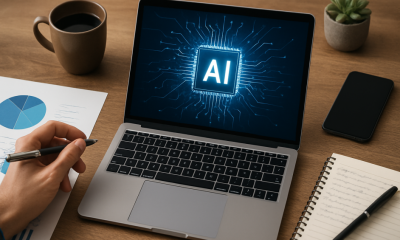Artificial Intelligence
What is AI Hyperpersonalization? Advantages, Case Studies, & Ethical Concerns

For decades, marketers have been researching the best strategies to create effective marketing campaigns to keep up with the ever-evolving consumer preferences. AI hyperpersonalization is a recent addition to a marketer’s arsenal.
Traditional marketing strategies rely on broad consumer segmentation that is beneficial for reaching larger groups. But this approach is sub-optimal for understanding individual needs.
Marketers have also successfully experimented with personalization techniques based on historical consumer data. An estimate suggests that worldwide revenue generated by customer experience personalization and optimization software will exceed $11.6 billion by 2026.
But this is not enough.
Modern consumers' needs are constantly evolving. They expect brands to understand their wants and needs – anticipate and exceed them. Hence, a more precise approach tailored to individual needs is required.
Today, marketers can use AI and ML-based data-driven techniques to take their marketing strategies to the next level – through hyperpersonalization. Let’s discuss it in detail.
What Is AI Hyperpersonalization?
AI hyperpersonalization or AI-powered hyperpersonalization is an advanced form of personalized marketing strategy that uses real-time data and individual journey maps along with AI, big data analytics, and automation to deliver highly contextualized and tailored content, products, or services to the right users at the right time through the right channels.
Real-time customer data is integral in hyperpersonalization as AI uses this information to learn behaviors, predict user actions, and cater to their needs and preferences. This is also a critical differentiator between hyperpersonalization and personalization – the depth and timing of the data used.
While personalization uses historical data such as customers’ purchase history, hyperpersonalization uses real-time data extracted throughout the customer journey to learn their behavior and needs. For instance, a customer journey powered by hyperpersonalization would target each customer with custom advertising, unique landing pages, tailored product recommendations, and dynamic pricing or promotions based on their geographic data, past visits, browsing habits, and purchase history.
The Mechanics of AI Hyperpersonalization
Hyperpersonalization using AI starts from data collection and ends in highly tailored user experiences. Let’s get a brief overview of the relevant steps.
1. Data Collection
There is no AI without data. In this step, customer data is collected from various sources such as:
- Browsing patterns
- Transaction history
- Preferred device
- Social media activity
- Geographic data
- Demographics
- Customers with similar preferences
- Existing customer databases
- IoT devices and more
2. Data Analysis
AI and ML algorithms analyze the collected data to identify patterns and trends. Depending upon the problem, customer data analysis can be:
- Descriptive (what's going on?)
- Diagnostic (why did it happen?)
- Predictive (what could happen in the future?)
- Prescriptive (what should we do about it?)
This step is significant as it extracts actionable insights from the raw data and helps understand each customer.
3. Prediction & Recommendation
Based on the data analysis, the AI & ML models can predict the customer's behavior. This could involve anticipating a customer's interests or potential objections, enabling businesses to serve the customer's specific preferences proactively and deliver real-time personalized content, offers, and experiences. For instance, Starbucks generates 400,000 variants of hyperpersonalized emails each week via its real-time personalization engine, targeting individual customer preferences.
Advantages of AI-powered Hyperpersonalization

Enhanced Customer Experience (CX) & Customer Engagement (CE)
When customers see the content/products/services tailored to their needs, it creates an intimate experience and enhances customer satisfaction. According to McKinsey research, 71% of customers expect a personalized experience, and 76% feel disappointed when they don’t get it.
Hyperpersonalization, therefore, eliminates generic experiences and replaces them with interactions that feel personalized and unique to each customer leading to increased engagement. The heightened level of engagement increases the likelihood of conversion and promises long-term customer loyalty.
Increased Sales & Revenue
A more relevant shopping or content experience means customers are more likely to find products or content they love and purchase, directly boosting sales and revenue. A whopping 97% of marketers report that personalization efforts positively impact business results. And a well-executed personalization strategy can deliver 5-8x ROI on marketing spend. Hence, by making the customer journey more intimate, hyperpersonalization improves conversion rates and increases average order value.
Prominent Case Studies of Hyperpersonalization Using AI
Case Study 1: E-commerce Industry (Amazon)
Amazon is a prime example of hyperpersonalization in the e-commerce industry. In 2022, Amazon's sales reached $469.8 billion, a 22% increase from 2021. The company uses a sophisticated AI-based recommendation engine that analyzes individual customer data, including;
- Past purchases
- Customer demographics
- Search query
- Items in the shopping cart
- Items that were checked out but not clicked
- Average spend amount
Amazon analyzes this data to create personalized product recommendations and send highly contextualized emails to each of its shoppers. As a result, their recommendation engine generates a healthy 35% conversion rate based on personalization.
Case Study 2: Entertainment Industry (Netflix)
Netflix has revolutionized the entertainment industry through its use of hyperpersonalization. Former VP of product innovation at Netflix has stated in an interview that:
“If one member in this tiny island expresses an interest for anime, then we're able to map that person to the global anime community. We know which are the best movies and TV shows for people in the world in that community.”
Reportedly, personalized recommendations save Netflix more than $1 billion every year. The company uses AI to analyze a vast array of customer data points, including:
- Viewing history
- Ratings given to different shows or movies
- Time of day when a user watches certain content
By analyzing vast amounts of highly contextualized data, Netflix suggests hyperpersonalized content according to the user’s preference. As a result, 80% of the content hours watched on Netflix come from the recommendation system, while 20% comes from searches. This enhances customer experience and engagement and reduces the churn rate.
Concerns & Ethical Implications of AI Hyperpersonalization
While the benefits of hyperpersonalization are tremendous, there are also crucial concerns and ethical implications to consider:
Privacy Issues
Users may be uncomfortable that their every click, purchase, or interaction is being tracked and analyzed, even if tracking intends to improve user experience. In September 2021, Netflix faced a fine of $190,000 imposed by the Personal Information Protection Commission (PIPC) of South Korea. Reportedly, Netflix violated its Personal Information Protection Act (PIPA) by engaging in the unlawful collection of personal information from users.
Consumer Manipulation
Hyperpersonalization could lead to increased consumer manipulation. With the knowledge of individual preferences and behaviors, companies can influence decision-making to a high degree, raising ethical questions about autonomy and consent. When companies know where you are, what you purchased, and your likes and dislikes, they are treading a tightrope between cool and creepy – with a high chance of entering the creepy realm.
In conclusion, hyperpersonalization, powered by AI and ML, has already brought significant advancements to various industries. However, its potential is yet to be fully actualized. For example, hyperpersonalization could translate into personalized medicine, with treatments and preventative strategies tailored to an individual patient's genetic makeup and lifestyle. However, these opportunities also have significant ethical implications and challenges that must be addressed.
For more AI-related content, visit unite.ai.












